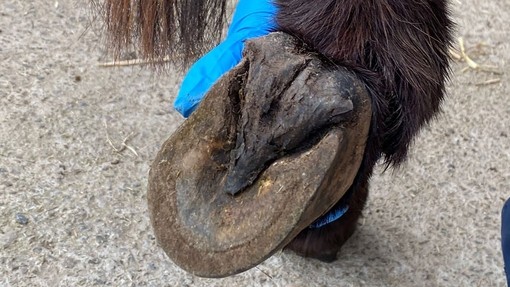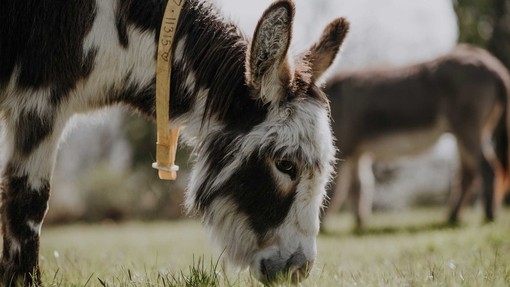
About Hoof care
Foot disease is commonly seen in donkeys but in many cases the conditions identified can be prevented by regular foot care and good husbandry.
Donkeys should have their feet picked out daily and should have their feet trimmed every 6-10 weeks. Their diet should be appropriately managed to avoid excessive weight gain, which can result in the development of laminitis.
Donkeys are very stoic so may only show subtle signs of foot pain particularly if they are only ever seen in the field. This is very evident with weight shifting where they may show no signs in the field but will show obvious weight shifting when observed on hard standing.
One of the main signs of foot pain is increased time lying down so this should not be seen as normal behaviour in elderly donkeys.
Prevention
The prevention of hoof disorders relies on the following throughout the life of the donkey:
- Appropriate nutrition and maintenance of a healthy body condition score (2.5 – 3)
- Regular foot care and farriery appropriate to the specific needs of the donkey
- A dry, clean environment, including stabling and exercise area
- Prompt attention as soon as signs of lameness are seen.

Donkeys are different
The donkey’s foot is structurally and anatomically different to that of a horse, which has implications for routine farriery and for the diagnosis and treatment of common foot conditions such as laminitis and seedy toe:
- The foot is more upright and has a cylindrical rather than conical shape
- Viewed from the solar surface the hoof is U-shaped rather than oval and the sole does not flake away so needs to be trimmed to create a concave sole
- The third phalanx (P3) sits more distally within the hoof capsule resulting in a larger distance between the coronary band and the extensor process of P3
- The point of frog does not extend as far dorsally.
Sharing expertise
The Donkey Sanctuary veterinary team, alongside experienced qualified farriers, provide practical training to farrier apprentices at various colleges and are happy to host qualified farriers who would like to get some donkey experience. The team are also happy to offer advice to vets and farriers in practice.
Hoof care resources
This course will provide you with valuable information for trimming donkey feet and applying orthopaedic treatments to donkey feet through sharing the different techniques used by The Donkey Sanctuary farriers and veterinary surgeons.

Find out the various problems and cures that can occur to your donkeys hooves and how to keep your donkeys' feet healthy.

This course is recommended for veterinary surgeons and veterinary students who may see donkeys occasionally and wish to be more confident in their knowledge and approach to this species.

Cryotherapy, also known as cold therapy, is a smart and easy adjunct to treatment for donkeys with acute laminitis – a serious inflammation of the ‘laminae’.

What is laminitis? Find out more about this cripplingly painful foot disease; it's causes, symptoms and how to treat your donkey effectively.

Join The Donkey Sanctuary's Senior Lead in Behaviour and Human Behaviour Change as he explores why feet handling is such a common issue for donkeys.

Discover more about the treatment of seven year old Christian, suffering from congenital flexural deformities of both distal interphalangeal joints (otherwise known as 'ballerina syndrome').

An owner's guide to preventing, recognising and treating white line disease (WLD, or seedy toe) in donkeys and mules.

Donkeys with laminitis need specialist feeding, which often requires major changes to feeding and other aspects of daily care.

